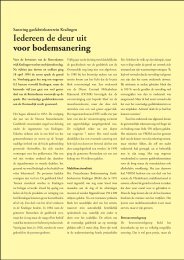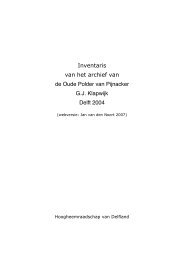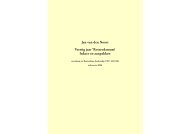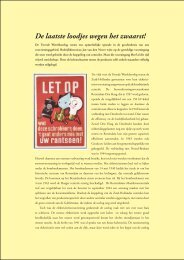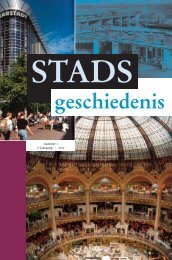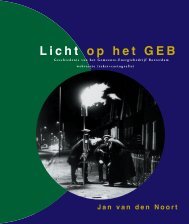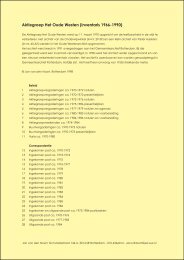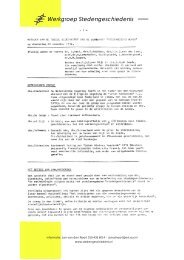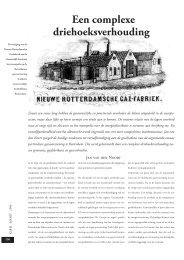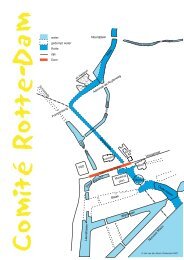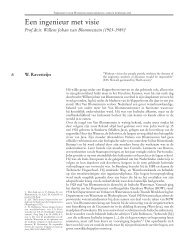Net Werk voor de Geschiedenis van Hygiene en Milieu, 1999-2001 ...
Net Werk voor de Geschiedenis van Hygiene en Milieu, 1999-2001 ...
Net Werk voor de Geschiedenis van Hygiene en Milieu, 1999-2001 ...
Create successful ePaper yourself
Turn your PDF publications into a flip-book with our unique Google optimized e-Paper software.
Fourier’s Theory of Terrestrial Temperatures;<br />
John Tyndall, S<strong>van</strong>te<br />
Arrh<strong>en</strong>ius, and Early Research on<br />
Carbon Dioxi<strong>de</strong> and Climate; T.<br />
C. Chamberlin and the Geological<br />
Ag<strong>en</strong>cy of the Atmosphere; The<br />
Climatic Determinism of Ellsworth<br />
Huntington; Global Warming<br />
The Early Tw<strong>en</strong>tieth C<strong>en</strong>tury; and<br />
Global Cooling, Global Warming:<br />
Historical Dim<strong>en</strong>sions.”<br />
Fraser Hart, J. The rural landscape,<br />
(Baltimore: Johns Hopkins,<br />
1998), ISBN 0801857171, 408<br />
blz.<br />
Hill, P. J. <strong>en</strong> R. E. Meiners (eds.),<br />
Who owns the Environm<strong>en</strong>t,<br />
(Lanham: Rowman and Littlefield<br />
Publishers, 1998), ISBN<br />
0847690814, 368 blz.<br />
Homer-Dix<strong>en</strong>, T. <strong>en</strong> J. Blitt Ecoviol<strong>en</strong>ce:<br />
Links among <strong>en</strong>vironm<strong>en</strong>t,<br />
population, and security,<br />
(Lanham: Rowman & Littlefield<br />
Publishers, 1998), ISBN<br />
0847688690, 256 blz.<br />
‘Ecoviol<strong>en</strong>ce’ explores links betwe<strong>en</strong><br />
<strong>en</strong>vironm<strong>en</strong>tal scarcities of key r<strong>en</strong>ewable<br />
resources-such as cropland,<br />
fresh water, and forests-and viol<strong>en</strong>t<br />
rebellions, insurg<strong>en</strong>cies, and ethnic<br />
clashes in <strong>de</strong>veloping countries.<br />
Detailed contemporary studies of<br />
civil viol<strong>en</strong>ce in Chiapas, Gaza,<br />
South Africa, Pakistan, and Rwanda<br />
show how <strong>en</strong>vironm<strong>en</strong>tal scarcity<br />
has played a limited to significant<br />
role in causing social instability in<br />
each of these contexts. Drawing<br />
upon theory and key findings from<br />
the case studies, the authors suggest<br />
that <strong>en</strong>vironm<strong>en</strong>tal scarcity will<br />
wors<strong>en</strong> in many poor countries in<br />
coming <strong>de</strong>ca<strong>de</strong>s and will become<br />
an increasingly important cause of<br />
major civil viol<strong>en</strong>ce.”<br />
Jobin, W., Dams and disease, (London:<br />
Routledge, <strong>1999</strong>), ISBN<br />
0419223606, 600 blz.<br />
Konijn<strong>en</strong>dijk, C. C., ‘A short<br />
history of urban forestry in Europe.’,<br />
Journal of Arboriculture,<br />
jrg. 23 (1997) January, pp. 31-<br />
39.<br />
Li<strong>de</strong>, J. H., Transforming Morocco:<br />
<strong>en</strong>vironm<strong>en</strong>tal change and<br />
social Or<strong>de</strong>r in the Gharb, 1912-<br />
1956, Phd University Of Maryland<br />
College Park (1998).<br />
“This dissertation examines the<br />
history of Fr<strong>en</strong>ch colonialism in<br />
morocco from an <strong>en</strong>vironm<strong>en</strong>tal<br />
perspective by studying the impact<br />
of Fr<strong>en</strong>ch rule on the Gharb, an<br />
agricultural region to the north of<br />
Rabat. As part of what they saw<br />
as being their ‘civilizing mission’<br />
in Morocco, the Fr<strong>en</strong>ch struggled<br />
to inscribe their own concepts of<br />
space, landscape, and <strong>en</strong>vironm<strong>en</strong>t<br />
onto the Gharb’s inhabitants. As a<br />
result, the 750,000 hectare region<br />
along the Sebou river became the<br />
focus of Fr<strong>en</strong>ch efforts to make<br />
Morocco ‘useful’ through manipulation<br />
of its <strong>en</strong>vironm<strong>en</strong>t and<br />
19<br />
20<br />
64<br />
contactblad <strong>van</strong> <strong>de</strong><br />
stichting net werk <strong>voor</strong> <strong>de</strong><br />
948-949<br />
geschie<strong>de</strong>nis <strong>van</strong> hygiëne <strong>en</strong> milieu<br />
redactie: myriam d a r u<br />
webversie: jan <strong>van</strong> <strong>de</strong>n n o o r t<br />
control over how Moroccans ma<strong>de</strong><br />
use of their own natural surroundings.<br />
This study of the Gharb sits<br />
at the intersection of rec<strong>en</strong>t tr<strong>en</strong>ds<br />
in three separate historical fields.<br />
As colonial history, it examines the<br />
contours of cultural domination<br />
expressed through <strong>en</strong>vironm<strong>en</strong>tal<br />
imagery. As <strong>en</strong>vironm<strong>en</strong>tal history,<br />
it investigates the un<strong>de</strong>rlying<br />
perceptions and motivations which<br />
influ<strong>en</strong>ced the creation of colonial<br />
landscapes. And as cultural history,<br />
it looks at the intimate relationship<br />
betwe<strong>en</strong> <strong>en</strong>vironm<strong>en</strong>tal controls<br />
and social or<strong>de</strong>r in a colonial setting.”<br />
Lovett, F. N., National Parks:<br />
Rights and the Common Good,<br />
(Lanham: Rowman and Littlefield,<br />
1998), ISBN 0847689778.<br />
Mcleod, K. S., Melting Snow: A reexamination<br />
of Dr. John Snow,<br />
his dot-map and the 1854 Broad<br />
Street cholera outbreak, (MA<br />
Carleton University (Canada)<br />
1998).<br />
“The mythical story of John Snow<br />
and the Broad Street outbreak is<br />
common in medical geography,<br />
epi<strong>de</strong>miology, and the history of<br />
medicine. In 1854, Snow i<strong>de</strong>ntified<br />
the source of the cholera outbreak<br />
in gol<strong>de</strong>n square (in pres<strong>en</strong>t-day<br />
soho) as the Broad Street pump,<br />
possibly with a dot-map of cholera<br />
<strong>de</strong>aths, and successfully argued for<br />
the removal of the pump’s handle.<br />
Many accounts state that this action<br />
<strong>en</strong><strong>de</strong>d the outbreak. In all<br />
three disciplines, snow is pres<strong>en</strong>ted<br />
as a hero because he showed how<br />
cholera is transmitted, because his<br />
i<strong>de</strong>as affected public health policy,<br />
and because he provi<strong>de</strong>d <strong>de</strong>finitive<br />
proof of a hypothesis. For medical<br />
geography, Snow’s heroic reputation<br />
is related to his <strong>de</strong>terminative use<br />
of a dot-map, and many authors<br />
feature the map in their pres<strong>en</strong>tations<br />
of the story. However, the<br />
tw<strong>en</strong>tieth-c<strong>en</strong>tury versions of this<br />
map can be quite differ<strong>en</strong>t from<br />
one another. This thesis re-examines<br />
the myth of John Snow, his dotmap,<br />
and the 1854 Broad Street<br />
outbreak--informed by archival<br />
research--and chall<strong>en</strong>ges the tak<strong>en</strong>for-granted<br />
repetition of the story<br />
in the three disciplines. The process<br />
of retelling the story <strong>en</strong>courages future<br />
investigation of the meaning of<br />
the myth in disciplinary contexts;<br />
of the nature of proof of causation;<br />
and of how evi<strong>de</strong>nce, argum<strong>en</strong>t and<br />
authority work in sci<strong>en</strong>ce.”<br />
Malamud, R. Reading zoos: repres<strong>en</strong>tations<br />
of animals and captivity,<br />
(New York: MacMillan Press,<br />
1998), ISBN 0333714067, 392<br />
blz.<br />
“Through an examination of mo<strong>de</strong>rn<br />
<strong>de</strong>pictions of zoos, Reading<br />
Zoos pres<strong>en</strong>ts a paradigm of how<br />
these institutions, and a range of<br />
reactions to them, illuminate the<br />
19/20<br />
<strong>Net</strong> <strong>Werk</strong> 64 - juni <strong>1999</strong><br />
20



